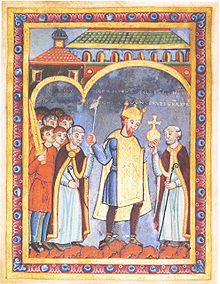Henry III, Holy Roman Emperor
| Henry III | |
|---|---|

Henry with the symbols of rulership attending the consecration of the Stavelot monastery church on 5 June 1040, mid-11th century miniature
|
|
| Holy Roman Emperor | |
| Reign | 25 December 1046 – 5 October 1056 |
| Coronation | 25 December 1046 St. Peter's Basilica, Rome |
| Predecessor | Conrad II |
| Successor | Henry IV |
|
King of Germany (Formally King of the Romans) |
|
| Reign | 14 April 1028 – 5 October 1056 |
| Coronation | 14 April 1028 Aachen Cathedral |
| Predecessor | Conrad II |
| Successor | Henry IV |
| King of Italy | |
| Reign | 4 June 1039 – 5 October 1056 |
| Predecessor | Conrad II |
| Successor | Henry IV |
| King of Burgundy | |
| Reign | 4 June 1039 – 5 October 1056 |
| Predecessor | Conrad II |
| Successor | Henry IV |
| Born | 28 October 1017 |
| Died | 5 October 1056 (aged 38) Bodfeld |
| Burial | Cathedral of Speyer |
| Spouse |
Gunhilda of Denmark Agnes of Poitou |
| Issue |
Beatrice I, Princess-Abbess of Quedlinburg Adelaide II, Princess-Abbess of Quedlinburg Henry IV, Holy Roman Emperor Conrad II, Duke of Bavaria Judith, Queen of Hungary |
| House | Salian Dynasty |
| Father | Conrad II, Holy Roman Emperor |
| Mother | Gisela of Swabia |
| Signum manus (1049) |  |
| German royal dynasties | |||
| Salian dynasty | |||
| Chronology | |||
| Conrad II | 1024 – 1039 | ||
| Henry III | 1039 – 1056 | ||
| Henry IV | 1056 – 1105 | ||
| Henry V | 1105 – 1125 | ||
| Family | |||
|
Family tree of the German monarchs |
|||
| Succession | |||
|
Preceded by Ottonian dynasty |
Followed by Süpplingenburg dynasty |
||
Henry III (28 October 1016 – 5 October 1056), called the Black or the Pious, was a member of the Salian Dynasty of Holy Roman Emperors. He was the eldest son of Conrad II of Germany and Gisela of Swabia. His father made him Duke of Bavaria (as Henry VI) in 1026, after the death of Duke Henry V.
On Easter Day 1028, after his father was crowned Holy Roman Emperor, Henry was elected and crowned King of Germany in the cathedral of Aachen by Pilgrim, Archbishop of Cologne.
After the death of Herman IV, Duke of Swabia in 1038, his father gave him that duchy, as well as the kingdom of Burgundy, which Conrad had inherited in 1033. Upon the death of his father on 4 June 1039, he became sole ruler of the kingdom and was crowned emperor by Pope Clement II in Rome (1046).
Henry's first tutor was Bruno, Bishop of Augsburg. On Bruno's death in 1029, Egilbert, Bishop of Freising, was appointed to take his place. In 1033, at the age of sixteen, Henry came of age and Egilbert was compensated for his services. In 1035, Adalbero, Duke of Carinthia, was deposed by Conrad, but Egilbert convinced Henry to refuse this injustice and the princes of Germany, having legally elected Henry, would not recognise the deposition unless their king did also. Henry, in accordance with his promise to Egilbert, did not consent to his father's act and Conrad, stupefied, fell unconscious after many attempts to turn Henry. Upon recovering, Conrad knelt before his son and exacted the desired consent. Egilbert was penalised dearly by the emperor.
...
Wikipedia
